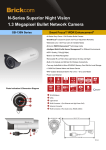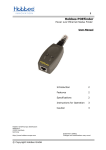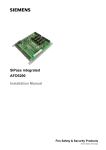Download User Manual
Transcript
Silvertel EVALPOE30W Rev 4 Evaluation Board User Manual Rev 4.0 – April 2012 EVALPOE30W Rev 4 - Evaluation Board User Manual 1 1 Table of Contents 1 2 3 4 Table of Contents 1 Table of Figures 1 Introduction 2 Board Description 2 4.1 Input Selection and Classification........................................................................ 2 4.2 PD Output Selection ............................................................................................ 4 4.3 Output adjustment ............................................................................................... 4 4.4 Minimum Load ..................................................................................................... 5 5 Typical Set-up 5 6 Using the Board 6 6.1 Typical Application .............................................................................................. 6 6.2 EVALPOE30W REV 4R - Evaluation Board Schematic ...................................... 7 6.3 Link settings ........................................................................................................ 7 2 Table of Figures Figure 1: Board Layout .................................................................................................... 3 Figure 2: Basic set-up ..................................................................................................... 5 Figure 3: Example set-up ................................................................................................ 6 EVALPOE30W Rev 4 - Evaluation Board User Manual 3 2 Introduction This manual is intended to be a guide to using the “EVALPOE30W Rev 4R” evaluation board with Silvertel Powered Device (PD) modules. The EVALPOE30W evaluation board can be powered using the spare pair in the CAT5e cable (pins 4 & 5 and pins 7 & 8), or over the data pair through on-board magnetics. 4 Board Description The EVALPOE30W Rev 4R evaluation board will work with the following products: Ag5000 Ag5100 The input data and power is supplied to the board through connector J1. The data is passed through to the peripheral equipment via J2, with the power form the PD module is supplied via J3 to J7 (see Figure 1 & 4). The EVALPOE30W on-board bridge rectifiers will ensure that the correct input polarity is applied to the PD. When using the Ag5000, there are two LED’s (LED1 and LED2) that indicates which input is applying the power (the silk screen on the PCB shows which pair SPARE or DATA). Because the Ag5100 has a common input, when the main power is applied from the PSE both LED will be ON. Before using the EVALPOE30W evaluation board, it is important to setup the input and output configuration jumpers for the product that is going to be use. 4.1 Input Selection and Classification Links LK3 and LK6 (see Figure 1) are used to setup the input configurations for each module. EVALPOE30W Rev 4 - Evaluation Board User Manual 3 Ag5000 - For Class 3 programming, LK3 should be fitted between the “b” and centre pins, LK6 should be fitted, for Class 0 remove both links. Ag5100 - LK3 should be fitted between the “a” and centre pins, LK6 should be removed. The Ag5100 is internally set to Class 4, when an IEEE802.3at PSE is connected to J1, the PSE should recognize this and apply a two event classification. If the classification conforms to the specification, the Ag5100 will recognize this and LED5 will turn ON. Non IEEE802.3at compliant PSE (including IEEE802.3af PSE’s) will only apply a single event classification and LED5 will remain OFF. Figure 1: Board Layout LK1, LK2, LK4 and LK5 are in series with each input pin, these links can be removed if you need to measure the input current (see Figure 4 for more information). EVALPOE30W Rev 4 - Evaluation Board User Manual 4 4.2 PD Output Selection Both the Ag5000 and Ag5100 have two DC outputs that must be connected in parallel or in series, the EVALPOE30W board output connections are shown in Table 1: Output 0V 1 VOUT 1 0V 2 VOUT 2 Connections J6 J5 J4 J3 J7 (Outer) J7 (Centre) Table 1: Output Connections The outputs cannot be run independently so the EVALPOE30W board has output selector links LK8 and LK9. For parallel outputs both of these links must be in position “a” - VOUT1 connected to VOUT 2 and 0V 1 connected to 0V 2. For series outputs both links must be in position “b” – VOUT 1 connected to 0V 2. The DC10 connector J7 delivers a nominal 12V when the outputs are in parallel and 24V when the outputs are in series (see Table 1 for connections). 4.3 Output adjustment The primary output (VOUT 1 – 0V 1) has an ADJ pin, which allows the output voltage to be increased or decreased from its nominal value. The secondary output (VOUT 2 – 0V 2) will track the adjusted primary output voltage. The EVALPOE30W board has an adjust link LK7 and two resistors R9 (100K) and R10 (0R) which allows the output to be adjusted to its maximum and (Ag5100) minimum values. To reduce the output voltage (to its minimum) connect a link to LK7 position “a”, to increase the output voltage (to its maximum) connect a link in position “b”. If the output voltage needs to be set to a different value (within the adjustment range) then connect a resistor instead of a (0R) link. EVALPOE30W Rev 4 - Evaluation Board User Manual 5 4.4 Minimum Load The PD module requires a minimum load of 200mA to maintain normal operation. The EVALPOE30W board if fitted with a 200mA load which can be applied by fitting LK10. If the external load connected to the board always exceeds 200mA, then this link does not need to be fitted. 5 Typical Set-up Figure 2 shows the basic set up using the POE evaluation board with a High Power Midspan or Endspan. The equipment required: ¾ ¾ ¾ ¾ ¾ Midspan or Endspan PSE (Power Sourcing Equipment) Peripheral (or Test) Equipment CAT5e cables Output power cable Mains cable Mains Supply Midspan / Endspan POE Eval Board Data & Power PC or Switch Data Peripheral Equipment J2 J1 J3 – J7 Figure 2: Basic set-up Data Power EVALPOE30W Rev 4 - Evaluation Board User Manual 6 6 Using the Board 6.1 Typical Application Figure 3 shows an example set-up using an Ag5000 powered by a Microsemi PD8001 Midspan and supplying +12V to a Vivotek PZ6122 (or PZ6112) ethernet camera. The PC ethernet port is connected to the data input of the PD8001 (PSE) via a short Cat5e patch cable. The Data & Power output from the POE30U-560 is connected to the input of the EVALPOE30W evaluation board (J1) via a CAT5e crossover cable. The data output of the EVALPOE30W evaluation board is connected to the data port of the ethernet camera via a short CAT5e patch cable. The +12V (parallel configuration) power output from the EVALPOE30W evaluation board (J7) connects to the dc input of the Vivotek PZ6122 ethernet camera. CAT5e Patch Cable Mains Supply EVALPOE30W POE30U-560 J2 Mains Data & Power PC J1 Ag5000 Data CAT5e Patch Cable CAT5e Crossover Cable Figure 3: Example set-up J7 Data +12V Vivotek PZ6122 Ethernet Camera EVALPOE30W Rev 4 - Evaluation Board User Manual 6.2 EVALPOE30W REV 4R - Evaluation Board Schematic 6.3 Link settings LK1 – Connects VA+ to BR1 + LK2 – Connects VA- to BR1 LK3 – Selects Class 3 programming (Ag5000) or “at” PSE detection (Ag5100) LK4 – Connects VB+ to BR2 + LK5 – Connects VB- to BR2 LK6 – Selects Class 3 programming (Ag5000) LK7 – Output adjust select LK8 & LK9 – Output configuration (Parallel “a” or Series “b”) LK10 – On-board 200mA load LK11 – “at” Opto output link 7



















